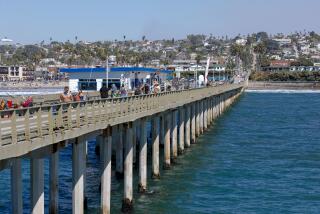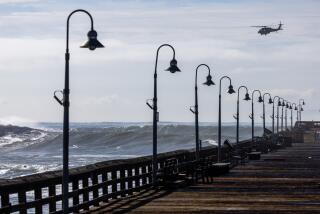Pathways to Salt Air and Ease
SOUTHWOLD, England â The accountant warned that piers arenât profitable. Builders said the cost of sinking piles 30 feet beneath the North Sea was prohibitive. Residents thought construction on the weather-beaten coast was a pipe dream.
Chris Iredale ignored them all. Fourteen years after buying a wood-planked stub at the waterâs edge, last month he opened the 620-foot Southwold Pier, the first such structure built on a British shore in 50 years and the latest example of the countryâs seaside revival.
âThis was a challenge, really, something completely different,â Iredale said. âIt was a challenge to bring it back to its former glory.â
The original pierâs glory days were at the turn of the last century, when Victorian doctors prescribed curative trips to the seashore and Britons traveled by paddle steamer to get their dose of fresh air and salt water. Nearly 100 piers served as landing platforms and promenades in that golden age for British resorts.
Over time, war, fire and the sea eroded the cast-iron and wood piers. Rail travel and cheap holiday packages abroad--where temperatures are less brisk than the average 67-degree highs of Britainâs summers--ate into the piersâ appeal. They fell into disrepair and then ruin in the 1960s and â70s, until only 55 were left standing, some of them just barely.
Pier enthusiasts say the walkways over the sea offer more than a meander down memory lane. Theyâre gateways to fresh air and freedom, wrote poet John Betjeman, who founded the National Piers Society in 1979. âPiers provide a walk on the sea,â he wrote, âwithout the disadvantage of being seasick.â
Piers also seem to ignite whatever it is in the English spirit that draws Britons to the beach even when it is cold and gray--which it nearly always is. With about 6,000 miles of coastline at their disposal, hardy Britons lay their wool blankets on the sand before going for an invigorating dip in something like melted ice. Afterward, they wrap themselves in wool sweaters to recover with a cup of hot tea.
And thatâs in the summer. In winter, they huddle in tents around a gas stove and watch their breath form clouds over a game of cards. Or they venture out in the rain to walk on a wet beach and watch waves crashing over the rocks.
These are rituals made all the sweeter by a pier on the landscape. Thanks to dogged individualists such as Iredale and to funds from the National Lottery and the European Union, British piers--and British beaches--are making a comeback. Seafront hotels are full, Britainâs coarse sand-and-pebble beaches are packed, and so are the renovated piers, with their array of restaurants, arcades and other amusements.
âThere is something about a pier in a seaside resort--nearly everybody loves a pier,â said Southwold native Stephen Cuffe, 56. âYou can walk on it and relax. You get a different angle on the town and see it from the sea end. It does something for you.â
Cuffe stared at the Southwold pier from the front of another seaside relic thatâs making a comeback--the beach hut. These brightly colored wooden shacks, measuring about 10 feet by 10 feet and boasting quirky names such as âGin ân It,â offer daytime shelter from the elements, a place to change and a postage-stamp kitchenette--all for purchase prices suddenly soaring above $25,000.
On this day, temperatures also were soaring unusually high. Newspapers reported with undisguised glee that at 90-plus degrees, it was hotter in Britain than in Hawaii and Cuba. Beaches were packed from Bournemouth to Brighton in southern England--as were their popular piers--and crowds rolled into out-of-the-way Southwold, about 100 miles northeast of London on the Suffolk coast.
âI had to look for parking for five minutes,â complained a local.
Around him, British faces shone red with sunburn. Unsuspecting bathers had brought cloth and posts to build wind barriers but had left home on this unusually still and cloudless day without the beach umbrellas and sunscreen normally reserved for southern Spain.
Pleasure-Seekers Savor Sunshine
Cuffe was undisturbed by the sudden influx of pleasure-seekers making their way to the new pier for a stroll, a cup of tea or an ice cream cone.
âItâs so simple, but gives so much pleasure to people,â he said. âItâs hard to imagine where people went before the pier.â
Southwold is one of six piers to undergo restoration since 1998, along with those at Swanage, Clevedon, Penarth, Southport and Saltburn by the Sea. It was the only one that needed to be completely rebuilt, a daunting project that Iredale admits led more rational minds to suspect he had lost his.
Iredale, a garden and gift wholesaler who moved from London to Suffolk for cheaper warehouse space, says he never saw the sea until he was 12. He was nosing around for another business venture when he came across the remains of Southwoldâs original timber pier and neglected promenade-side pavilion. Against the advice of that accountant, he bought them in 1987 for an undisclosed price.
He managed to renovate the pavilion to rent out for weddings and other celebrations, but contractors wanted more than $2 million to build a 500-foot pier. That was far more than he had to invest.
But then Iredale hit on the idea of doing the work himself, with his own crane and local builders. He got a bank loan and an EU grant for nearly $110,000 and launched a fund-raising scheme selling brass plaques on the pier for about $30 to $90 each. Hundreds of them line the pier rails with marriage proposals, birth announcements and whimsical messages such as âI do love to be beside the seaside.â
Iredaleâs projected budget of about $500,000 has ballooned--to about $1.5 million--since he started construction, but so has the size of the reinforced pier. It stretches 620 feet into the sea and isnât finished yet. The crane perched on the end of it is building a T-shaped extension so that the Waverly, Britainâs sole surviving paddle steamer, will be able to dock there and unload tourists from London.
At first, many of Southwoldâs 1,380 full-time residents watched the project with disbelief. They never thought that Iredale would actually get the money together and be able to fight the elements to restore the pier.
Next, they watched with apprehension. They take pride in their townâs traditional aspect--with brick row houses and a plethora of pubs serving locally made beer--which has changed little since the days of the original pier. The main difference between old seafront photographs and new ones is the disappearance of the Victorian buggies that carried modest bathers to the waterâs edge so they could slip discreetly into the sea.
Residentsâ Skepticism Turns to Respect
Southwold residents say they feared that a pier would bring all sorts of bells and whistles, and a proliferation of kitsch shops. They point disdainfully to âtackyâ piers in other towns that reek of fish and chips, or to the overcrowding of Brighton, whose arcade and ride-filled Palace Pier drew 3.4 million visitors last year.
Brightonâs West Pier, once considered the jewel of British piers, has been awarded a Heritage Lottery Fund grant of about $20 million for its renovation. Complaints from Palace Pierâs owners that Brighton isnât big enough for two piers fell on deaf ears.
Concerns voiced by the residents of Southwold did not. Iredale says he took pains to give the pier the understated character of the town.
âNothing too garish,â he said.
Its white buildings house a cafe, a pub and an exhibit room full of old photographs and âamazing factsâ alongside replicas of the crown jewels. There is a collection of oddball machines by a local inventor and a water clock sculpture that enthralls children on the hour and half-hour. In the pavilion, there is an amusement arcade with as many old-fashioned games as electronic toys.
With this, the pier and Iredale have won the respect of Southwold residents, an admittedly reticent group for whom the word âlocalâ is an honorific to be earned over decades.
âI think the pier brings character to the town. Itâs lovely to have it back,â said Sue Allen, a local since 1948.
âHe hasnât lost the integrity of it,â Louise Pratt, 52, said as she served an English breakfast to her children and grandchildren at their beach hut that looks out on the pier.
The only question, Pratt mused aloud, is whether Iredale will be able to maintain the pier against the elements and eroding beachfront.
âThere is a lot of paint and planks there,â she said, âand this is a very, very cruel coast.â
That comes as no surprise to Iredale, who already has seen the sea crash through the back wall of his arcade, pushing his game machines into the parking lot. He expects to have to replace several planks each year and is hoping his buildings prove sturdy.
Improvisation Marks One Pierâs Evolution
Whether they will last long enough to turn a profit is a question Iredale canât answer. As with everything else to do with the pier, he seems to be working this out as he goes along.
âI donât know whether I am ever going to see it pay for itself in my lifetime,â he said. âBut whatâs the point of building up all your assets buying blocks of flats? Iâve done something here that people can see and take pleasure in.â
As he spoke, people were arriving in droves to walk the pier and stop for a rest on the deck chairs, where they contemplated the horizon behind the rise of Iredaleâs crane.
And about that crane--just how does Iredale propose to get it off the pier once heâs finished construction? He hasnât figured that out yet.
More to Read
Sign up for The Wild
Weâll help you find the best places to hike, bike and run, as well as the perfect silent spots for meditation and yoga.
You may occasionally receive promotional content from the Los Angeles Times.






